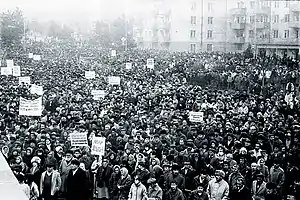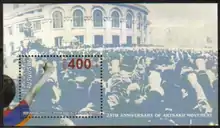Karabakh movement
The Karabakh movement (Armenian: Ղարաբաղյան շարժում, also the Artsakh Movement[7][8] Արցախյան շարժում) was a national mass movement[9] in Armenia and Nagorno-Karabakh from 1988 to 1992 that advocated for the transfer of the mainly Armenian-populated Nagorno-Karabakh Autonomous Oblast of neighboring Azerbaijan to the jurisdiction of Armenia.
| Karabakh movement | |||
|---|---|---|---|
| Part of the Nagorno-Karabakh conflict and the dissolution of the Soviet Union | |||
 The first major demonstration in Stepanakert, February 13, 1988 | |||
| Date | 13 February 1988 — 30 April 1991 | ||
| Location | |||
| Goals | Unification of Nagorno-Karabakh with Armenia | ||
| Methods | Demonstrations, sit-ins, strikes, hunger strike, student protest, civil disobedience | ||
| Resulted in | Establishment of the Nagorno-Karabakh Republic Escalation of the First Nagorno-Karabakh War | ||
| Parties to the civil conflict | |||
| Lead figures | |||
| |||
| Number | |||

Initially, the movement was entirely devoid of any anti-Soviet sentiment and did not call for independence of Armenia. The Karabakh Committee, a group of intellectuals, led the movement from 1988 to 1989. It transformed into the Pan-Armenian National Movement (HHSh) by 1989 and won majority in the 1990 parliamentary election. In 1991, both Armenia and Nagorno-Karabakh declared independence from the Soviet Union. The intense fighting known as the first Nagorno-Karabakh War turned into a full-scale war by 1992.
Timeline
1987
- September: the Union for National Self-Determination, the first non-Communist party, established in Armenia by Paruyr Hayrikyan
- October 17: the first protests concerning ecological issues held in Yerevan[10]
- October 18: a minor rally on Freedom Square, Yerevan for the unification of Karabakh with Armenia[10]
1988
- February 13: First demonstration in Stepanakert.[11] Traditionally considered the start of the movement.[12]
- February 18–26: Major demonstrations held in Yerevan for the unification of Karabakh with Armenia.[13]
- February 20: the NKAO Supreme Council issued a request to transfer the region to Soviet Armenia
- February 22–23: Local Armenians and Azerbaijanis clash in Askeran, resulting in several deaths
- February 26: Demonstrations paused after Mikhail Gorbachev's asked for time to develop a position.[14]
- February 27–29: Sumgait pogrom starts, Armenians of Azerbaijan start to leave in large numbers[14]
- March 9: Gorbachev meets with the leaders of Armenia and Azerbaijan Karen Demirchyan and Kamran Baghirov in Moscow to discuss the public demands of unification of Armenia and Karabakh.[15]
- March 22: Over 100,000 people discontented with the tendencies demonstrate in Yerevan.[16]
- March 23: The Supreme Soviet of the Soviet Union rejects the demand of NKAO Regional Party.[16]
- March 25: Gorbachev rejects Armenian claims, forbade demonstrations in Yerevan.[16]
- March 26: Despite not being authorized by the Moscow government, tens of thousands demonstrate in Yerevan.[17]
- March 30: NKAO Communist Party adopts a resolution demanding unification.[17]
- April 24: Hundreds of thousands of Armenians march to the genocide memorial in Yerevan.[17]
- May 21: Karen Demirchyan resigns.
- May 28: Flag of Armenia first raised in front of Matenadaran.[18]
- June 15: Soviet Armenian Supreme Council votes in favor of the unification of NKAO.[18]
- June 17: Soviet Azerbaijani Supreme Council opposes the transfer of NKAO to Armenia.[18]
- June 28–29: Conference of the Communist Party of the Soviet Union disapproves Armenian claims to NKAO.[18]
- July 5: Zvartnots Airport clash, the Soviet troops confronted by protesters in Zvartnots Airport, one man left dead, tens injured.[19]
- July 12: NKAO Soviet Council votes in favor of unification with Armenia.[19]
- July 18: Soviet Supreme Council refuses Armenian claims.[19]
- July 21: Paruyr Hayrikyan deported to Ethiopia.[19]
- fall: Around 150,000 Azerbaijanis of Armenia start to leave in large numbers.
- September: State of emergency declared in Stepanakert after Armenian and Azerbaijanis clash.
- November: Kirovabad pogrom
- November 7: Hundreds of thousands demonstrate in Yerevan to support the Karabakh Committee.[20]
- November 22: Soviet Armenian Supreme Council recognizes the Armenian Genocide.[20]
- November 24: State of emergency declared in Yerevan.[20]
- December 7: Armenian earthquake.
- December 10: Karabakh Committee members arrested, sent to Moscow.[21]
1989
- March 16: Metsamor Nuclear Power Plant shut down.
- May 31: Karabakh Committee members freed.
- December 1: Soviet Armenian Supreme Council and NKAO Supreme Council declare the unification of the two entities
1990
- January 13–19: Pogrom of Armenians in Baku.
- May 20: 1990 Armenian parliamentary election, pro-independence members form majority.
- August 4: Levon Ter-Petrosyan elected chairman of the Supreme Council, de facto leader of Armenia.
- August 23: Soviet Armenian Supreme Council declared independence.
1991
- April 30 – May 15: First Nagorno-Karabakh War: Soviet and Azeri forces deport thousands of Armenians from Shahumyan during Operation Ring.
- August 19–21: 1991 Soviet coup d'état attempt
- September 2: Nagorno-Karabakh Republic proclaimed in Stepanakert.[22]
References
- Flag of Armenia was adopted on August 24, 1990.
- "Soviet Armenia erupts in protests". The Daily News. 24 February 1988. Retrieved 16 July 2013.
- Armenians protest USSR’s refusal to honor Nagomo-Karabakh annexation referendum, 1988 Matthew Heck, Global Nonviolent Action Database, December 5, 2010
- "Pravda Talks of Ethnic Woes". New York Times. 19 April 1988. Retrieved 16 July 2013.
As many as one million people demonstrated in the Armenian capital of Yerevan in February to demand that Nagorno-Karabakh be made part of Armenia
- "Mass Protests Said to Flare In Soviet Armenian Capital". New York Times. 31 May 1988. Retrieved 16 July 2013.
- "The Press-Courier - Google News Archive Search". news.google.com.
- "An event dedicated to the 25th anniversary of the Artsakh Movement taken place at the US Congress". Ministry of Foreign Affairs Nagorno-Karabakh Republic. 13 February 2012. Retrieved 4 August 2013.
- "The Artsakh Movement started on this day 25 years ago". Public Radio of Armenia. 20 February 2013. Retrieved 4 August 2013.
- Panossian, Razmik (2006). The Armenians: From Kings and Priests to Merchants and Commissars. New York: Columbia University Press. p. 385. ISBN 9780231139267.
The Gharabagh movement in Armenia—as mobilised for and through the issue of the enclave’s unification to the republic—is a prime example of a mass national movement.
- "Reports of demonstrations in Yerevan and Clashes in Mountainous Karabagh". Asbarez. 24 October 1987. Archived from the original on September 14, 2007. Retrieved 29 May 2013.
- de Waal 2003, p. 11.
- "Karabakh Armenians mark 25th anniversary of liberation movement". ArmeniaNow. 14 February 2013. Retrieved 19 August 2013.
- Verluise 1995, p. 86.
- Verluise 1995, p. 87.
- Verluise 1995, p. 89.
- Verluise 1995, p. 90.
- Verluise 1995, p. 91.
- Verluise 1995, p. 92.
- Verluise 1995, p. 93.
- Verluise 1995, p. 97.
- Verluise 1995, p. 99.
- Zürcher, Christoph (2007). The Post-Soviet Wars: Rebellion, Ethnic Conflict, and Nationhood in the Caucasus ([Online-Ausg.]. ed.). New York: New York University Press. p. 168. ISBN 9780814797099.
Bibliography
- Verluise, Pierre (1995). Armenia in Crisis: The 1988 Earthquake. Detroit: Wayne State University Press. ISBN 9780814325278.
- de Waal, Thomas (2003). Black Garden: Armenia and Azerbaijan through peace and war. New York: New York University Press. ISBN 9780814719459.